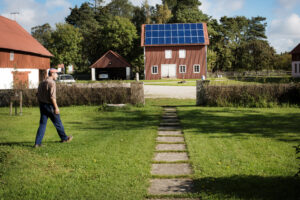Energy generation puts pressure on cities, citizens, and the environment through carbon emissions, water usage, impacts on land and rivers and other forms of pollution. Vast energy savings can be done with relatively small measures and has great potential to lower both environmental and societal costs.
Buildings, industry, transport, and mobility are all identified as the sectors with the largest potential for energy saving. This is true in industrialised as well as developing countries. These sectors are markedly different from each other but also have many challenges in common, like creating and maintaining sustainable systems of power supply, heating, cooling, and lighting, just to name a few.
Sweden has identified energy efficiency as one of its main priorities and sees it as a central instrument to achieve higher levels of sustainability. With ambitious targets set in the Energy Agreement and Climate Framework, Sweden aims to become a net-zero carbon economy by 2045. To achieve this goal, Sweden applies a holistic approach to promote cooperation between multiple actors across several levels including the public sector, industry, academia, and households.
The Swedish model of building broad coalitions and working across different sectors to achieve sustainability has resulted in measurable impacts. Everything from reformed national subsidies and regulations to energy-efficient municipal planning and the development of technology procurement. However, a sustainable city is not created by only replacing inefficient lightbulbs, it encompasses a whole ecosystem of solutions, which can only come into effect when sustainability is approached from a holistic perspective – where the sum is larger than its parts.
The future
According to the International Energy Agency, improvements in energy efficiency have been declining since 2015. Continuous progress plays a crucial role, not only in reaching key sustainability targets but also in sustaining competitiveness and economic growth. Therefore, the slowdown of improvements can have major implications not only for sustainability but also for the more general economic development of governments and businesses.

Image by Karl Melander/imagebank.sweden.se
Even though Sweden’s work in energy efficiency has led to great results so far, more needs to be done. A singular focus on increasing the amount of energy efficiency-related investments is not the most effective way to create a sustainable and efficient energy infrastructure.
This complex challenge needs a solution where the issue is tackled through a combination of subsidies, regulations, and a culture of cooperation that allows for an innovative business climate to thrive. The combination of energy labelling of products, targeted economic subsidies to the industry and further development of networks for innovative solutions can help create solutions that enable flexible and efficient energy use.
1990: The first model of technology procurement for specific technical challenges in buildings is implemented.
1995: The Swedish carbon tax is implemented.
1998: The Swedish Energy Agency is founded.
2001: Sweden’s first passive house is built.
2002: The climate investment programme (Klimp) is introduced, promoting climate investments in Sweden (approx. 100 million EUR).
2005: The Swedish Energy Agency’s PFE programme is launched. The programme was intended to increase energy efficiency in energy-intensive industries.
2012: The Energy Efficiency Directive stipulates the Energy efficiency first-principle. The principle implies ensuring that energy-saving solutions are not overlooked or undervalued. It also aims at removing barriers preventing energy efficiency improvements and implementing policies that will prioritize investment in energy efficiency.
2017: Sweden adopts a new climate policy framework. The framework consists of a climate act, climate targets and a climate policy council. Sweden’s long-term target is to have zero net greenhouse gas emissions by 2045 at the latest.